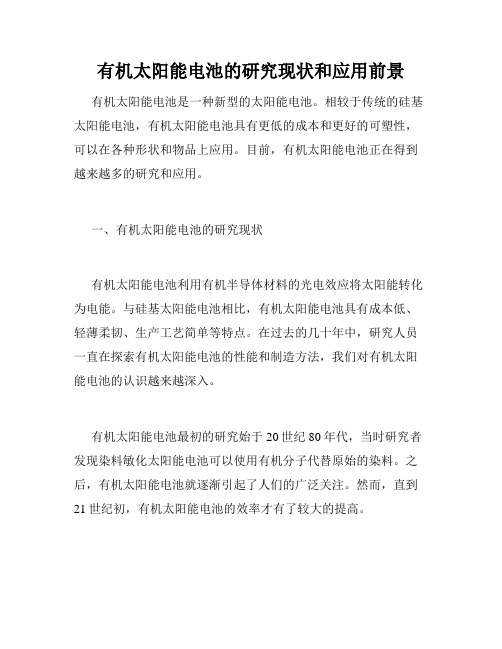太阳能电池研究现状
太阳能光伏技术研发及应用现状与前沿

太阳能光伏技术研发及应用现状与前沿太阳能光伏技术是当前最为热门的新能源技术之一,在世界范围内得到了广泛应用和推广。
以下为太阳能光伏技术的研发及应用现状与前沿的相关参考内容:1. 研发现状(1)晶薄太阳能电池技术晶薄太阳能电池技术是近年来快速发展的一种新型电池技术,其具有体积小、重量轻、柔性好、透明性高等优点,在建筑物、交通工具等领域有广泛应用前景。
(2)高效太阳能电池技术高效太阳能电池技术是目前太阳能光伏技术研发的热点之一,主要集中在晶体硅太阳能电池与薄膜太阳能电池等方面。
研究人员通过材料优化、外延生长技术、光学设计等手段,不断提高太阳能电池的转化效率和稳定性,使其在实际应用中具有更高的性价比和可靠性。
(3)钙钛矿太阳能电池技术钙钛矿太阳能电池技术是一种新兴的太阳能电池技术,在高效性和较低生产成本方面具有潜在优势。
目前研究人员已经通过材料改进和制备工艺优化等措施,使得钙钛矿太阳能电池的转化效率逐步提高,并在实验室条件下达到了超过25%的高效率。
2. 应用现状(1)太阳能光伏电站太阳能光伏电站是目前太阳能光伏技术最为成熟的应用之一,其集中式装置能够实现大规模电力供应,具有内部化风险少、经济效益高等优点。
目前全球已建成的太阳能光伏电站已经突破1000GW,其中新能源光伏发电占比逐年增大。
(2)户用太阳能光伏发电系统户用太阳能光伏发电系统是近年来得到广泛应用的分布式光伏电站,其具有方便快捷、灵活可调等优点,能够满足家庭、企事业单位等不同需求的供电需求。
目前,我国已建成众多的户用太阳能光伏发电系统,为新能源的普及和推广做出了重要贡献。
3. 应用前沿(1)光伏-储能技术光伏-储能技术是近年来新兴的技术热点之一,其能够解决光伏电站存在的间歇性供电问题,提高太阳能的利用效率和经济效益。
目前,光伏-储能技术已经在我国多个城市实现了应用,并取得显著成效。
(2)可穿戴太阳能光伏设备可穿戴太阳能光伏设备是太阳能光伏技术应用的新型领域,包括太阳能手表、太阳能背包、太阳能充电宝等多种应用形式。
太阳能电池的研究现状及发展前景

太阳能电池的研究现状及发展前景太阳能电池是一种将太阳光能直接转化为电能的器件。
它是现代清洁能源领域中备受瞩目的技术之一。
随着对环境污染和非可再生能源的担忧日益增加,太阳能电池作为一种可持续发展和环保的选择,正变得越来越热门。
本文将介绍太阳能电池的研究现状及发展前景。
一、太阳能电池的研究现状太阳能电池是利用半导体材料制成的电池,其工作原理是将光子能量转化为电子能量。
现在最常用的太阳能电池是硅基太阳能电池。
硅基太阳能电池已发展了几十年,其效率已经逐渐接近极限。
然而,硅基太阳能电池的成本仍然比较高,对大规模应用来说仍然不够经济实惠。
为了降低成本同时提高太阳能电池的效率,研究人员正在寻找替代性材料。
一些新兴材料被广泛研究,如钙钛矿、有机太阳能电池和复合太阳能电池等。
其中,钙钛矿太阳能电池由于其高效率和低成本而备受关注。
与硅基太阳能电池相比,钙钛矿太阳能电池不但具有更高效率,而且材料成本也更便宜。
因此,钙钛矿太阳能电池被认为是一种有望在未来大规模应用的技术。
二、太阳能电池的发展前景随着对环境污染和非可再生能源的担忧日益增加,太阳能电池作为一种可持续发展和环保的选择越来越受到重视。
据国际能源机构预测,到2030年,太阳能电力将成为全球电力消费量中最大的单一来源之一。
在未来几年中,太阳能电池技术将继续发展,效率将逐步提高,成本也将进一步下降。
此外,在不断涌现的新材料和新技术的推动下,太阳能电池将不断完善,性能将不断提升。
总的来说,太阳能电池是一种前景广阔的清洁能源技术。
它可以为世界各地的人们提供可靠、廉价的电力,同时帮助我们减少对环境的破坏,降低对化石燃料的依赖。
因此,在国际上,太阳能电池技术被认为是实现可持续发展的关键技术之一。
三、结语太阳能电池作为一种可持续发展和环保的技术,已经成为了清洁能源领域中备受瞩目的一种技术。
虽然目前太阳能电池的研究仍在进行之中,但已经取得了很大的进展。
未来,随着新材料和新技术的涌现,太阳能电池将变得更加高效、便宜和可靠,同时也将为我们提供更多的清洁能源选择。
有机无机杂化太阳能电池的研究及应用前景

有机无机杂化太阳能电池的研究及应用前景近年来,太阳能电池在能源转型中扮演着越来越重要的角色。
然而,传统的无机材料太阳能电池普遍存在成本高、体积大、稳定性差等问题,因此,有机无机杂化太阳能电池成为了备受关注的研究领域。
本文将探讨有机无机杂化太阳能电池的研究现状以及未来的应用前景。
一、有机无机杂化太阳能电池的基本原理有机无机杂化太阳能电池是一种“三明治”结构,其内部由有机材料和无机材料构成,并且各自承担不同的功能。
通常情况下,有机材料是光电转换的活性层,负责将光线转化为电子能量;无机材料则是电荷传输的通道,负责将活性层中的电子和正空穴输送到电路中。
这种混凝土结构的设计方案不仅解决了传统太阳能电池的成本问题,而且通过材料之间的相互作用和调节,可以提高电池的效率和稳定性。
二、有机无机杂化太阳能电池的研究现状有机无机杂化太阳能电池除了解决成本问题,更吸引人的是其对于柔性电池、多色电池的应用前景。
当前,有机无机杂化太阳能电池的研究集中于两个方向:一是有机材料的优化,主要是以新型共轭高分子为主体;二是功能化纳米结构的设计,如石墨烯、金属氧化物等,目的是提高电池的效率和稳定性。
有机颜料分子是传统材料,但由于它的光电转换效率低,所以不符合实际需要,如何提高其光电转换效率成为了研究的重要方向之一。
不同于普通的太阳能电池,有机无机杂化太阳能电池在研究中走的是另一条路线,即在光电转换层中引入新的材料,旨在改变材料光电特性,提高光电转换效率。
另一方面,旨在提高材料的电导率,以便更快地传输自由载流子,从而提高电池的效率。
报道显示,与无机电池结构相比,当一个薄层的有机材料与无机材料混合时,电荷可更快和更高效地转移到金属半导体中。
因此,有机无机杂化太阳能电池的效率也更高。
可以预见,有机材料和无机材料之间的相互作用和调节将更加细致,因此效率会进一步提高。
三、有机无机杂化太阳能电池的应用前景由于他们可以制成柔性薄膜,有机无机杂化太阳能电池比传统太阳能电池更加适合用于可曲折电子器件。
太阳能电池技术的研究现状和未来

太阳能电池技术的研究现状和未来太阳能电池作为一种清洁、环保、可再生的能源源,近年来引发了广泛的关注和研究。
随着科技的发展和应用逐渐成熟,太阳能电池的性能和效率也在不断提升。
本文将从太阳能电池的基本原理出发,述说太阳能电池技术的研究现状、未来发展和应用前景。
太阳能电池的基本原理太阳能电池也叫光电池,是将太阳能转化为电能的一种设备。
太阳能电池的基本结构由P型半导体、N型半导体和界面组成。
当太阳光线照射到P型半导体和N型半导体交界处时,会产生一定的电场,使得自由电子从N型半导体向P型半导体移动,从而产生电流。
太阳能电池的电流与电池面积成正比,与太阳辐照度和电池温度之积成正比,与太阳照射面的倾角、方向和阴影的影响成反比。
太阳能电池的研究现状随着太阳能电池技术的不断发展和变革,其效率和运行性能也有了巨大的提升。
目前,太阳能电池主要分为单晶硅、多晶硅、非晶硅、染料敏化晶体管和钙钛矿太阳能电池等多种类型。
其中,钙钛矿太阳能电池是近年来发展的一种新型太阳能电池,在效率和成本等方面均有很大的潜力。
单晶硅太阳能电池是较早的一种太阳能电池,其效率较高,但成本较高。
多晶硅太阳能电池的效率略低于单晶硅太阳能电池,但成本更便宜。
非晶硅太阳能电池是一种薄膜太阳能电池,其成本和制造难度低,但效率较低。
染料敏化太阳能电池是一种新型太阳能电池,其效率和成本均有很大潜力。
钙钛矿太阳能电池是一种效率非常高的太阳能电池,且成本相对较低,具有广阔的应用前景。
太阳能电池的未来发展太阳能电池是一种非常有前途的新能源,其在未来的应用前景也十分广阔。
随着环保意识的逐步提高,太阳能电池的需求量也将逐渐增加。
在未来,太阳能电池的主要发展方向包括以下几个方面:增强效率:太阳能电池的效率是目前研究的热点之一,提高效率可能是太阳能电池未来的主要发展方向。
目前,钙钛矿太阳能电池具有较高的效率,成为了太阳能电池研究的一大热点。
降低成本:太阳能电池虽然具有广泛的应用前景,但其成本较高,制约了其在大规模应用方面的发展。
太阳能电池技术发展现状及未来趋势

太阳能电池技术发展现状及未来趋势太阳能电池是一种利用太阳能转化为电能的设备,是可再生能源领域的关键技术之一。
随着人们对清洁能源需求的不断增加,太阳能电池技术也得到了长足的发展。
本文将对太阳能电池技术的现状及未来趋势进行探讨。
当前,太阳能电池技术已经取得了许多重大突破,使之成为可靠的替代传统能源的选择。
目前市场上主流的太阳能电池技术包括单晶硅、多晶硅、薄膜太阳能电池等。
单晶硅太阳能电池以其高转换效率和长寿命在市场上占据一定比例,但其制造成本较高。
多晶硅太阳能电池具有较低的制造成本和较高的效率,是目前应用最广泛的太阳能电池技术之一。
薄膜太阳能电池则具有柔性、轻便的特点,但其转换效率相对较低。
在技术发展方面,太阳能电池技术正在朝着提高转换效率、降低成本、增强可持续性和适应多种应用等方向发展。
研究人员正在不断探索新材料和新结构,以提高太阳能电池的效率。
例如,针对传统硅基电池的限制,研发人员开始探索钙钛矿太阳能电池。
钙钛矿太阳能电池具有较高的转换效率和较低的制造成本,被视为未来重要的技术突破。
此外,有机太阳能电池也被广泛研究,具有制备工艺简单和低成本的优势,但其稳定性和效率仍然需要进一步提升。
另外,太阳能电池的成本也一直是制约其广泛应用的主要因素之一。
随着技术进步和规模效应的不断发挥,太阳能设备的制造成本得到了明显下降。
同时,一些新型太阳能电池材料的研发也有望降低成本。
例如,钙钛矿太阳能电池的低制造成本和高效率使其成为替代传统太阳能电池的有力竞争者。
随着钙钛矿技术的进一步成熟,太阳能电池的价格将显著下降,进一步推动其市场应用。
除了提高效率和降低成本,太阳能电池技术还将朝着提高可持续性和适应多种应用的方向发展。
在可持续性方面,研究人员正在探索使用环境友好和可再生的材料制造太阳能电池,以减少对环境的影响。
同时,太阳能电池与能源储存技术的结合也是发展的重要方向之一。
通过储能技术,太阳能可以在光照不足或夜间继续供应电力,使太阳能电池系统更加可靠、灵活。
有机太阳能电池的研究现状和应用前景

有机太阳能电池的研究现状和应用前景有机太阳能电池是一种新型的太阳能电池。
相较于传统的硅基太阳能电池,有机太阳能电池具有更低的成本和更好的可塑性,可以在各种形状和物品上应用。
目前,有机太阳能电池正在得到越来越多的研究和应用。
一、有机太阳能电池的研究现状有机太阳能电池利用有机半导体材料的光电效应将太阳能转化为电能。
与硅基太阳能电池相比,有机太阳能电池具有成本低、轻薄柔韧、生产工艺简单等特点。
在过去的几十年中,研究人员一直在探索有机太阳能电池的性能和制造方法,我们对有机太阳能电池的认识越来越深入。
有机太阳能电池最初的研究始于20世纪80年代,当时研究者发现染料敏化太阳能电池可以使用有机分子代替原始的染料。
之后,有机太阳能电池就逐渐引起了人们的广泛关注。
然而,直到21世纪初,有机太阳能电池的效率才有了较大的提高。
现在,科学家们已经开发出了许多种类、结构和形状的有机太阳能电池。
其中,非富勒烯有机太阳能电池是目前最具潜力的一种。
2014年以前,有机太阳能电池的最高转换效率一直停留在10%以下,但是随着非富勒烯有机太阳能电池的出现,转换效率得到了重大提高,从而使得有机太阳能电池更加实用。
二、有机太阳能电池的应用前景有机太阳能电池的应用前景非常广阔。
由于其成本低,所以它可以广泛应用于各种领域。
目前,有机太阳能电池已经在众多领域有了应用。
1.智能建筑有机太阳能电池可以嵌入到玻璃、塑料和纸张等材料中,从而用于智能建筑中。
有机太阳能电池不仅可以为智能建筑提供电能,还可以在墙壁、窗户和屋顶上实现光伏发电,并可以与智能家居系统进行连接。
2.便携式电子设备有机太阳能电池适用于便携式电子设备,例如智能手机、笔记本电脑和平板电脑等。
相较于传统的锂电池,有机太阳能电池成本更低,并且可以更加灵活,因此它在便携式电子设备上应用的前景非常广阔。
3.户外运动器材有机太阳能电池也可以用于户外运动器材,例如智能手表、智能眼镜和智能手环等。
这些电子产品由于长时间使用,其电池寿命较短,而有机太阳能电池可以在户外充电,从而更加实用。
太阳能电池技术的发展现状与未来
太阳能电池技术的发展现状与未来随着气候变化问题的日益突出,清洁能源的需求变得越来越迫切。
而太阳能电池技术作为一种绿色、可再生的能源解决方案,受到了越来越多人的关注。
本文将探讨太阳能电池技术的发展现状以及未来的发展趋势。
一、太阳能电池技术的发展现状太阳能电池技术已经有几十年的历史,经过多年的发展,已经取得了可喜的进展。
目前,主流的太阳能电池技术主要包括多晶硅太阳能电池、单晶硅太阳能电池和薄膜太阳能电池。
多晶硅太阳能电池是市场上应用最为广泛的一种技术,其制作工艺相对简单,成本较低。
但是,多晶硅太阳能电池在效率上仍然有一定的提升空间,其效率一般在15%到20%之间。
相比之下,单晶硅太阳能电池的效率要高一些,甚至可以达到20%以上。
单晶硅太阳能电池在能量转化效率和稳定性方面的表现更好,但其制造过程相对复杂,造成了较高的成本。
薄膜太阳能电池则是近年来崛起的一种新技术,不同于传统的硅基太阳能电池,它采用了柔性材料作为基底,可以实现轻薄柔性化的电池制作。
尽管薄膜太阳能电池的效率较低,但其开发潜力巨大,可以应用于各类可穿戴设备、移动通信和智能建筑等领域。
二、太阳能电池技术的未来发展方向在太阳能电池技术的未来发展中,人们将继续努力提高电池的能量转化效率、降低成本以及改进电池的稳定性和可靠性。
首先,提高能量转化效率是目前太阳能电池技术亟待解决的问题。
科学家们正在研究新材料、优化制造工艺,以提高电池的效率。
例如,利用纳米技术可以增加太阳能电池的吸收能力,提高光的利用率。
此外,研发更高效的光伏材料也是未来发展的重要方向之一。
其次,降低成本是推广太阳能电池技术的关键所在。
随着技术的进步和规模的扩大,太阳能电池的制造成本逐渐下降。
然而,成本仍然是限制太阳能电池技术大规模应用的瓶颈。
因此,继续改进制造工艺、降低材料成本以及提高电池的寿命,都将有助于降低太阳能电池的成本。
最后,改善太阳能电池的稳定性和可靠性也是未来发展的方向之一。
太阳能电池的发展现状与未来趋势
太阳能电池的发展现状与未来趋势太阳能电池,作为可再生能源的重要组成部分,已经成为当今社会可持续发展的关键技术之一。
本文将从技术发展、市场应用和未来趋势三个方面对太阳能电池的发展现状进行探讨。
第一部分:技术发展太阳能电池的技术发展经历了几十年的积累和演进。
最早的太阳能电池是由硅材料制成的,称为单晶硅太阳能电池。
然而,由于制造难度高、成本高昂,以及工作效率低等问题,单晶硅太阳能电池一直受限于规模化应用。
随着科技的进步,多晶硅太阳能电池和薄膜太阳能电池等新型材料逐渐崭露头角。
多晶硅太阳能电池制造工艺相对简单,成本较低,同时工作效率也有所提高。
而薄膜太阳能电池则具有柔性、轻薄、透明等优势,具备更广阔的应用场景。
此外,还有一些新型太阳能电池技术不断涌现。
例如有机太阳能电池可以实现颜色和形状的灵活设计,有望嵌入到建筑物、电子产品等各种载体中。
钙钛矿太阳能电池具有高效、低成本的特点,近年来取得了显著的突破。
第二部分:市场应用随着太阳能电池技术的成熟和价格的下降,太阳能产业得到了迅猛发展。
目前,太阳能电池广泛应用于家庭光伏发电、商业光伏发电和大规模电站等领域。
在家庭光伏发电方面,越来越多的家庭开始安装太阳能电池板,利用太阳能自行发电。
这不仅可以降低对传统能源的依赖,减少碳排放,还可以通过售电上网实现经济效益。
商业光伏发电则主要指的是工业和商业领域的太阳能发电项目。
由于工厂、商场等场所的用电量较大,太阳能发电可以有效降低用电成本,同时满足绿色能源需求。
此外,大规模太阳能电站也在全球范围内广泛建设。
这些电站通常由数百甚至上千个太阳能电池组成,能够为城市或地区提供大量的清洁能源。
第三部分:未来趋势太阳能电池在未来的发展前景令人充满期待。
随着科技和工艺的不断进步,太阳能电池的效率将进一步提高,成本将进一步降低。
科学家们正在开展各种研究,尝试开发出更高效、更稳定的材料,并不断优化制造工艺。
另外,太阳能电池与储能技术的结合也是未来的一个趋势。
有机太阳能电池研究现状与进展
有机太阳能电池研究现状与进展
有机太阳能电池是一种可以将太阳能转化为电能的光电转换器件,相比于传统的硅基太阳能电池,有机太阳能电池具有成本低、可塑性好、轻量化等优点,因此备受关注。
以下介绍有机太阳能电池的研究现状与进展:
1. 效率提高:过去十年来,有机太阳能电池的功率转换效率不断提高,目前已经达到了17%左右,接近商业化水平。
2. 新材料的发展:研究者在寻找更优秀的有机材料方面进行了大量尝试,包括聚合物、小分子有机化合物和混合材料等,以提高有机太阳能电池的效率、稳定性和可持续性。
3. 有机太阳能电池的稳定性:为了解决有机太阳能电池的稳定性问题,研究者设计了新型材料和界面,探究了各种稳定剂和先进封装技术。
4. 柔性有机太阳能电池:在光电转换效率较高的情况下,有机太阳能电池适合制作柔性器件,形态可塑性好,可以应用于更广泛的领域。
目前柔性有机太阳能电池的商业化应用仍处于起步阶段,但未来充满潜力。
总的来说,有机太阳能电池的研究不断取得进展,但与传统硅基太阳能电池相比仍面临诸多挑战,例如效率、稳定性和成本等。
未来需要进一步探究新材料和工艺,提高有机太阳能电池的性能和可应用性。
太阳能电池技术现状与未来发展
太阳能电池技术现状与未来发展太阳能电池技术作为一种绝对的绿色能源已经成为未来的发展方向。
太阳能电池是将太阳能直接转换为电能的一种装置,利用光电效应将太阳能转换为电能。
在当前关注环保的大背景下,太阳能电池技术可谓备受关注。
本文将从现状、未来以及应用等方面进行探讨。
一、太阳能电池技术现状1、太阳能电池的发明背景人类对于太阳能一直都有很高的价值和兴趣。
早在公元前七世纪,古希腊的焦托斯就曾经利用镜子将太阳的光线聚焦点燃某些物体。
此外,太阳能的利用也曾经被用于水的升降,磨面粉,沐浴和游泳等活动。
1950年代初期,太阳能电池的概念被首次明确提出。
在20世纪50年代,人们将二极管制作在材料GaN上,而GaN薄膜上则用了合适的电极,形成了一种简单的太阳能电池。
由此可见,太阳能电池的发展历程十分漫长,并需要长时间的探索研究。
到了21世纪,太阳能电池技术已经有了明显的提升,同时制造成本也有大幅度下降,可以大批量生产,投入市场使用。
目前,太阳能电池的发明者巴丁和碧雅翰已获得了诺贝尔奖。
太阳能电池技术也得到了各方面的广泛认可和青睐。
2、太阳能电池技术的分类太阳能电池是一种直接将光能转化为电能的装置,目前太阳能电池的种类较多,常见的太阳能电池有单晶硅太阳能电池、多晶硅太阳能电池、非晶硅太阳能电池、染料敏化太阳能电池以及有机太阳能电池等。
其中,单晶硅太阳能电池的发电效率最高,因此目前在市场上占据主导位置。
但是,单晶硅太阳能电池制作成本较高,同时生产中对材料质量要求较高。
3、太阳能电池技术的特点太阳能电池具有清洁可再生、长期使用、无噪音等诸多特点。
此外,太阳能电池的维护费用较低,不需要添加燃料等,只要有阳光,就可以持续发电。
但目前太阳能电池存在一些问题,例如效率不高、加工流程复杂、占地面积大等多种限制。
随着技术的飞速发展,解决这些问题是必不可少的。
二、太阳能电池技术未来发展1、太阳能电池的研发走向未来太阳能电池的研发重点将会是提高效率、降低成本以及提高稳定性,同时不断推动太阳能电池技术的发展。
- 1、下载文档前请自行甄别文档内容的完整性,平台不提供额外的编辑、内容补充、找答案等附加服务。
- 2、"仅部分预览"的文档,不可在线预览部分如存在完整性等问题,可反馈申请退款(可完整预览的文档不适用该条件!)。
- 3、如文档侵犯您的权益,请联系客服反馈,我们会尽快为您处理(人工客服工作时间:9:00-18:30)。
矿产资源开发利用方案编写内容要求及审查大纲
矿产资源开发利用方案编写内容要求及《矿产资源开发利用方案》审查大纲一、概述
㈠矿区位置、隶属关系和企业性质。
如为改扩建矿山, 应说明矿山现状、
特点及存在的主要问题。
㈡编制依据
(1简述项目前期工作进展情况及与有关方面对项目的意向性协议情况。
(2 列出开发利用方案编制所依据的主要基础性资料的名称。
如经储量管理部门认定的矿区地质勘探报告、选矿试验报告、加工利用试验报告、工程地质初评资料、矿区水文资料和供水资料等。
对改、扩建矿山应有生产实际资料, 如矿山总平面现状图、矿床开拓系统图、采场现状图和主要采选设备清单等。
二、矿产品需求现状和预测
㈠该矿产在国内需求情况和市场供应情况
1、矿产品现状及加工利用趋向。
2、国内近、远期的需求量及主要销向预测。
㈡产品价格分析
1、国内矿产品价格现状。
2、矿产品价格稳定性及变化趋势。
三、矿产资源概况
㈠矿区总体概况
1、矿区总体规划情况。
2、矿区矿产资源概况。
3、该设计与矿区总体开发的关系。
㈡该设计项目的资源概况
1、矿床地质及构造特征。
2、矿床开采技术条件及水文地质条件。
